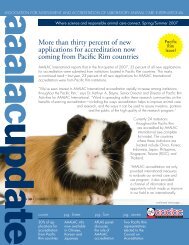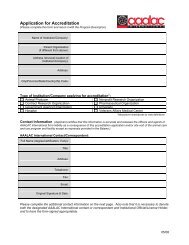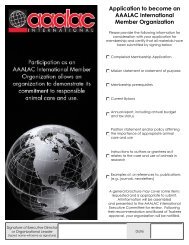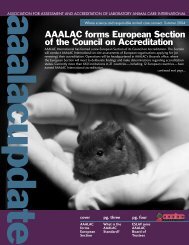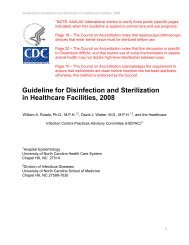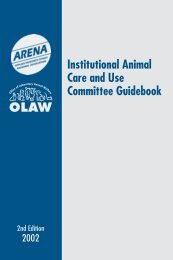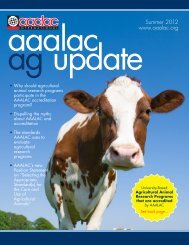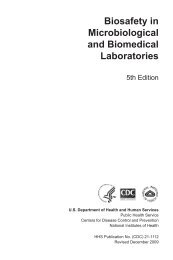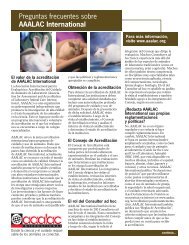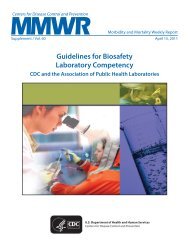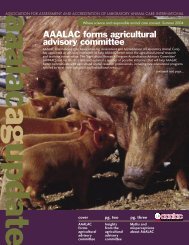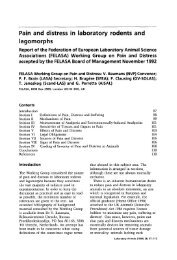24 CHAPTER 3screened with 1.3-cm (0.5-<strong>in</strong>) mesh, <strong>and</strong> ceil<strong>in</strong>gs withridge vents should be screened with 1.9-cm (0.75-<strong>in</strong>)mesh to m<strong>in</strong>imize rodent <strong>and</strong> bird entry. Smaller meshsizes are recommended where <strong>the</strong>y will not <strong>in</strong>terferewith airflow. Mesh may need to be <strong>in</strong>stalled along foundationsbelow ground level, especially with wood foundations.Pesticides should be used only as approved (Hodgson,1980). Particular caution should be exercised withrespect to residues <strong>in</strong> feedstuffs, which could <strong>in</strong>jure animals<strong>and</strong> (or) eventually pass <strong>in</strong>to <strong>the</strong> meat, milk, oreggs (Willett et al., 1981). Pesticides should be used <strong>in</strong>or around animal facilities only when necessary, onlywith <strong>the</strong> approval <strong>of</strong> <strong>the</strong> scientist whose animals willbe exposed to <strong>the</strong>m, <strong>and</strong> with special care. A pesticideapplicator or a commercial service may be used.In some regions, wildlife (e.g., skunks, raccoons, <strong>and</strong>foxes) <strong>and</strong> stray cats <strong>and</strong> dogs may spread zoonotic diseases,<strong>in</strong>clud<strong>in</strong>g rabies, to agricultural animals. In highrisklocations, <strong>in</strong>stitutions should implement an educationalprogram that <strong>in</strong>cludes tra<strong>in</strong><strong>in</strong>g scientific <strong>and</strong>animal care personnel to recognize <strong>the</strong> signs <strong>of</strong> rabies <strong>in</strong>both wildlife <strong>and</strong> agricultural species <strong>and</strong> to h<strong>and</strong>le <strong>and</strong>report potentially rabid animals. Inoculation may beadvisable <strong>for</strong> humans who may come <strong>in</strong>to contact withanimals <strong>in</strong> regions where rabies is endemic.Many agricultural <strong>in</strong>stitutions keep cats <strong>for</strong> pest-controlpurposes. Although <strong>the</strong> use <strong>of</strong> free-roam<strong>in</strong>g cats isa traditional <strong>for</strong>m <strong>of</strong> pest control <strong>for</strong> agricultural facilities,cats may limit <strong>the</strong> ability <strong>for</strong> bait<strong>in</strong>g <strong>and</strong> maypresent hygiene or accident risks or serve as diseasevectors (Van’t Woudt, 1990; Van Sambeek et al., 1995;Vantassel et al., 2005). However, when cats are present,proper veter<strong>in</strong>ary care <strong>and</strong> oversight should be providedto <strong>the</strong>se animals. Veter<strong>in</strong>ary care should <strong>in</strong>cludevacc<strong>in</strong>ations, parasite control, <strong>and</strong> neuter<strong>in</strong>g.Sometimes procedures that result <strong>in</strong> temporary distress<strong>and</strong> even some pa<strong>in</strong> are necessary to susta<strong>in</strong> <strong>the</strong>long-term welfare <strong>of</strong> animals or <strong>the</strong>ir h<strong>and</strong>lers. Thesepractices <strong>in</strong>clude (but are not limited to) comb-, toe-,<strong>and</strong> beak-trimm<strong>in</strong>g <strong>of</strong> chickens; bill-trimm<strong>in</strong>g <strong>of</strong> ducks;toenail removal, beak-trimm<strong>in</strong>g, <strong>and</strong> snood removal <strong>of</strong>turkeys; dehorn<strong>in</strong>g <strong>and</strong> ho<strong>of</strong>-trimm<strong>in</strong>g <strong>of</strong> cattle; taildock<strong>in</strong>g<strong>and</strong> shear<strong>in</strong>g <strong>of</strong> sheep; tail-dock<strong>in</strong>g, neonatalteeth-clipp<strong>in</strong>g, ho<strong>of</strong>-trimm<strong>in</strong>g, <strong>and</strong> tusk-cutt<strong>in</strong>g <strong>of</strong>sw<strong>in</strong>e; <strong>and</strong> castration <strong>of</strong> males <strong>and</strong> spay<strong>in</strong>g <strong>of</strong> females <strong>in</strong>some species. Some <strong>of</strong> <strong>the</strong>se procedures reduce <strong>in</strong>juriesto humans <strong>and</strong> o<strong>the</strong>r animals (e.g., cannibalism, tailbit<strong>in</strong>g,<strong>and</strong> gor<strong>in</strong>g). Castration, <strong>for</strong> example, reduces<strong>the</strong> chances <strong>of</strong> aggression aga<strong>in</strong>st o<strong>the</strong>r animals. Bulls<strong>and</strong> boars also cause many serious <strong>in</strong>juries to humans(Han<strong>for</strong>d <strong>and</strong> Fletcher, 1983). St<strong>and</strong>ard agriculturalpractices that are likely to cause pa<strong>in</strong> should be reviewed<strong>and</strong> approved by <strong>the</strong> IACUC. Recommendationsregard<strong>in</strong>g <strong>the</strong>se practices <strong>for</strong> <strong>the</strong> different speciesare found <strong>in</strong> Chapters 6 through 11. The development<strong>and</strong> implementation <strong>of</strong> alternative procedures less likelyto cause pa<strong>in</strong> or distress are encouraged. Overall, bestpractices <strong>for</strong> pa<strong>in</strong> prevention <strong>and</strong> control should be followed.Sick, Injured, <strong>and</strong> Dead <strong>Animals</strong>Sick <strong>and</strong> <strong>in</strong>jured animals should be segregated from<strong>the</strong> ma<strong>in</strong> group when feasible, observed thoroughly atleast once daily, <strong>and</strong> provided veter<strong>in</strong>ary care as appropriate.Incurably ill or <strong>in</strong>jured animals <strong>in</strong> chronicpa<strong>in</strong> or distress should be humanely killed (see Chapter2 <strong>and</strong> Chapters 6 through 11) as soon as <strong>the</strong>y arediagnosed as such. Dead animals are potential sources<strong>of</strong> <strong>in</strong>fection. Their disposal should be accomplishedpromptly by a commercial render<strong>in</strong>g service or o<strong>the</strong>rappropriate means (e.g., burial, compost<strong>in</strong>g, or <strong>in</strong>c<strong>in</strong>eration)<strong>and</strong> accord<strong>in</strong>g to applicable ord<strong>in</strong>ances <strong>and</strong>regulations. Postmortem exam<strong>in</strong>ation <strong>of</strong> fresh or wellpreservedanimals may provide important animal health<strong>in</strong><strong>for</strong>mation <strong>and</strong> aid <strong>in</strong> prevent<strong>in</strong>g fur<strong>the</strong>r losses. Whenwarranted <strong>and</strong> feasible, waste <strong>and</strong> bedd<strong>in</strong>g that havebeen removed from facilities occupied by an animalthat has died should be moved to an area that is <strong>in</strong>accessibleto o<strong>the</strong>r animals. More <strong>in</strong><strong>for</strong>mation regard<strong>in</strong>gsick, <strong>in</strong>jured, <strong>and</strong> dead animals is available <strong>in</strong> Chapter2: <strong>Agricultural</strong> Animal Health <strong>Care</strong>.HANDLING AND TRANSPORTAdditional details on <strong>the</strong> h<strong>and</strong>l<strong>in</strong>g, restra<strong>in</strong>t, <strong>and</strong>transportation <strong>of</strong> animals are given <strong>in</strong> Chapter 5: AnimalH<strong>and</strong>l<strong>in</strong>g <strong>and</strong> Transport.STANDARD AGRICULTURALPRACTICESNoiseSPECIAL CONSIDERATIONSNoise from animals <strong>and</strong> animal care activities is<strong>in</strong>herent <strong>in</strong> <strong>the</strong> operation <strong>of</strong> any animal facility. Althoughdifferences exist <strong>in</strong> perceived loudness <strong>of</strong> <strong>the</strong>same sound (Algers et al., 1978a,b), occupational noiselimitations have been established <strong>for</strong> workers, <strong>and</strong> employeesshould be provided appropriate hear<strong>in</strong>g protection<strong>and</strong> monitored <strong>for</strong> <strong>the</strong>ir effects (Mitloehner <strong>and</strong>Calvo, 2008).Noise ord<strong>in</strong>arily experienced <strong>in</strong> agricultural facilitiesgenerally appears to have little permanent effect on <strong>the</strong>per<strong>for</strong>mance <strong>of</strong> agricultural animals (Bond, 1970; NRC,1970), although Algers <strong>and</strong> Jensen (1985, 1991) foundthat cont<strong>in</strong>uous fan noise disrupted suckl<strong>in</strong>g <strong>of</strong> pigs.Sudden loud noises have also been reported to causehysteria <strong>in</strong> various stra<strong>in</strong>s <strong>of</strong> chickens (Mills <strong>and</strong> Faure,1990).
Metabolism Stalls <strong>and</strong> O<strong>the</strong>r IntensiveProceduresHUSBANDRY, HOUSING, AND BIOSECURITY<strong>Animals</strong> that are subjected to <strong>in</strong>tensive procedures requir<strong>in</strong>gprolonged restra<strong>in</strong>t, frequent sampl<strong>in</strong>g, or o<strong>the</strong>rprocedures experience less stress if <strong>the</strong>y are tra<strong>in</strong>ed tocooperate voluntarily with <strong>the</strong> procedure. Cattle, pigs,<strong>and</strong> o<strong>the</strong>r animals can be tra<strong>in</strong>ed with food rewards toaccept <strong>and</strong> cooperate with various procedures, such asjugular venipuncture (Panep<strong>in</strong>to, 1983; Calle <strong>and</strong> Bornmann,1988; Gr<strong>and</strong><strong>in</strong>, 1989; Gr<strong>and</strong><strong>in</strong> et al., 1995).Many studies <strong>of</strong> <strong>the</strong> nutrition <strong>and</strong> physiology <strong>of</strong> agriculturalanimals use a specialized piece <strong>of</strong> equipment,<strong>the</strong> metabolism stall. Successful designs have been reported<strong>for</strong> various species (Mayo, 1961; Welch, 1964;Baker et al., 1967; Stillions <strong>and</strong> Nelson, 1968; Woodenet al., 1970). These stalls give animal research <strong>and</strong> carepersonnel easy access to <strong>the</strong> animal <strong>and</strong> its excreta.The degree <strong>of</strong> restra<strong>in</strong>t <strong>of</strong> animals housed <strong>in</strong> metabolismstalls is substantially different from that <strong>of</strong> o<strong>the</strong>rmethods that restrict mobility (e.g., stanchions <strong>and</strong>te<strong>the</strong>r<strong>in</strong>g). <strong>Animals</strong> <strong>in</strong> metabolism stalls are <strong>of</strong>ten heldby a head gate or neck te<strong>the</strong>r <strong>and</strong> are restricted <strong>in</strong> <strong>the</strong>irlateral <strong>and</strong> longitud<strong>in</strong>al mobility. These differences mayexacerbate <strong>the</strong> effects <strong>of</strong> restriction on animals housed<strong>in</strong> metabolism stalls (Bowers et al., 1993). Metabolismstalls should be used only <strong>for</strong> approved studies, not<strong>for</strong> <strong>the</strong> purpose <strong>of</strong> rout<strong>in</strong>e hous<strong>in</strong>g. <strong>Research</strong>ers shouldconsider appropriate alternatives to metabolism stalls(such as determ<strong>in</strong>ation <strong>of</strong> digestibility by marker methods)if such alternatives are available.There should be a sufficient precondition<strong>in</strong>g periodto ensure adequate adjustment <strong>and</strong> com<strong>for</strong>t <strong>of</strong> <strong>the</strong> animalto <strong>the</strong> metabolism stall be<strong>for</strong>e sample collectionstarts. The length <strong>of</strong> <strong>the</strong> precondition<strong>in</strong>g period shouldbe subject to approval <strong>of</strong> <strong>the</strong> IACUC. At least enoughspace should be provided <strong>in</strong> <strong>the</strong> metabolism stall <strong>for</strong><strong>the</strong> animal to rise <strong>and</strong> lie down normally. When possible,metabolism stalls should be positioned so that<strong>the</strong> animal is <strong>in</strong> visual, auditory, <strong>and</strong> olfactory contactwith conspecific animals to m<strong>in</strong>imize <strong>the</strong> effects <strong>of</strong> socialisolation.Thermal requirements <strong>of</strong> animals may be affectedwhen <strong>the</strong>y are placed <strong>in</strong> metabolism stalls. For example,<strong>the</strong> lower critical environmental temperature <strong>of</strong> ananimal held <strong>in</strong>dividually <strong>in</strong> a metabolism stall is higherthan when resid<strong>in</strong>g <strong>in</strong> a group because <strong>the</strong> s<strong>in</strong>gle animalcannot obta<strong>in</strong> <strong>the</strong> heat-conserv<strong>in</strong>g benefits <strong>of</strong> huddl<strong>in</strong>gwith group-mates.<strong>Animals</strong> <strong>in</strong> metabolism stalls should be observedmore frequently than those <strong>in</strong> o<strong>the</strong>r environments, <strong>and</strong>particular attention should be paid to changes <strong>in</strong> behavior<strong>and</strong> appetite <strong>and</strong> <strong>the</strong> condition <strong>of</strong> sk<strong>in</strong>, feet, <strong>and</strong>legs. The length <strong>of</strong> time an animal may rema<strong>in</strong> <strong>in</strong> ametabolism stall be<strong>for</strong>e removal <strong>for</strong> exercise should bebased on pr<strong>of</strong>essional judgment <strong>and</strong> experience <strong>and</strong> besubject to approval by <strong>the</strong> IACUC. The species <strong>and</strong><strong>the</strong> degree <strong>of</strong> restra<strong>in</strong>t imposed by particular stall typesshould be taken <strong>in</strong>to consideration <strong>in</strong> mak<strong>in</strong>g such judgments.Recommendations <strong>for</strong> particular species can befound <strong>in</strong> <strong>the</strong> appropriate chapters <strong>of</strong> this guide.25BIOSECURITYThe term biosecurity <strong>in</strong> an agricultural sett<strong>in</strong>g hashistorically been def<strong>in</strong>ed as <strong>the</strong> security measures takento prevent <strong>the</strong> un<strong>in</strong>tentional transfer <strong>of</strong> pathogenic organisms<strong>and</strong> subsequent <strong>in</strong>fection <strong>of</strong> production animalsby humans, verm<strong>in</strong>, or o<strong>the</strong>r means (i.e., bioexclusion).Biosecurity is also applied <strong>in</strong> <strong>the</strong> same contextto agricultural animals used <strong>in</strong> <strong>the</strong> field <strong>of</strong> agriculturalresearch, teach<strong>in</strong>g, <strong>and</strong> test<strong>in</strong>g. With <strong>the</strong> advent <strong>of</strong> bioterrorism<strong>and</strong> <strong>the</strong> designation <strong>of</strong> select agents, <strong>the</strong> termbiosecurity has acquired new def<strong>in</strong>itions, depend<strong>in</strong>g on<strong>the</strong> field to which it is applied. Biosecurity is now usedto def<strong>in</strong>e national <strong>and</strong> local policies <strong>and</strong> procedures thataddress <strong>the</strong> protection <strong>of</strong> food <strong>and</strong> water supplies from<strong>in</strong>tentional contam<strong>in</strong>ation <strong>and</strong> is additionally used todef<strong>in</strong>e measures required to ma<strong>in</strong>ta<strong>in</strong> security <strong>and</strong> accountability<strong>of</strong> select agents <strong>and</strong> tox<strong>in</strong>s. It is importantto underst<strong>and</strong> <strong>the</strong>se concepts when us<strong>in</strong>g <strong>the</strong> term <strong>and</strong>to clarify that <strong>in</strong> this section we are us<strong>in</strong>g <strong>the</strong> term biosecurity<strong>in</strong> <strong>the</strong> context <strong>of</strong> prevent<strong>in</strong>g <strong>the</strong> un<strong>in</strong>tentionaltransfer <strong>of</strong> pathogens to animals <strong>and</strong> humans throughappropriate facility design, tra<strong>in</strong><strong>in</strong>g, <strong>and</strong> precautions(i.e., immunizations). For example, personnel work<strong>in</strong>g<strong>in</strong> sw<strong>in</strong>e <strong>and</strong> poultry facilities should be immunizedaga<strong>in</strong>st <strong>in</strong>fluenza <strong>and</strong> receive tra<strong>in</strong><strong>in</strong>g related to potentialcross-contam<strong>in</strong>ation <strong>of</strong> agents between animals <strong>and</strong>humans. The USDA has published voluntary guidel<strong>in</strong>es<strong>and</strong> a checklist as a resource to help <strong>the</strong> agriculturalproducer reduce security risks at <strong>the</strong> farm level (USDA,2006). This publication is designed to prevent both <strong>in</strong>tentional<strong>and</strong> un<strong>in</strong>tentional <strong>in</strong>troduction <strong>of</strong> pathogensat <strong>the</strong> farm level. A list <strong>of</strong> references <strong>and</strong> resources isalso provided <strong>in</strong> this document on a variety <strong>of</strong> farm biosecurityissues. O<strong>the</strong>r sources <strong>of</strong> <strong>in</strong><strong>for</strong>mation <strong>in</strong>clude reviews<strong>of</strong> biosecurity basics <strong>and</strong> good management practices<strong>for</strong> prevent<strong>in</strong>g <strong>in</strong>fectious diseases <strong>and</strong> biosecurity<strong>of</strong> feedstuffs (Buhman et al., 2000; BAMN, 2001). All<strong>of</strong> <strong>the</strong>se publications <strong>of</strong>fer <strong>in</strong><strong>for</strong>mation <strong>and</strong> suggestionsthat could be evaluated <strong>for</strong> <strong>the</strong>ir impact on <strong>the</strong> design<strong>of</strong> an animal facility.It is essential that <strong>the</strong> agricultural animal care staffma<strong>in</strong>ta<strong>in</strong> a high st<strong>and</strong>ard <strong>of</strong> biosecurity to protect <strong>the</strong>animals from pathogenic organisms that can be transferredby humans. Good biosecurity beg<strong>in</strong>s with personalcleanl<strong>in</strong>ess. Shower<strong>in</strong>g or wash<strong>in</strong>g facilities <strong>and</strong>supplies should be provided, <strong>and</strong> personnel shouldchange <strong>the</strong>ir cloth<strong>in</strong>g as <strong>of</strong>ten as necessary to ma<strong>in</strong>ta<strong>in</strong>personal hygiene. Disposable gear such as gloves, masks,coats, coveralls, <strong>and</strong> shoe covers may be required undersome circumstances. Personnel should not leave <strong>the</strong>work place <strong>in</strong> protective cloth<strong>in</strong>g that has been wornwhile work<strong>in</strong>g with animals. Personnel should not bepermitted to eat, dr<strong>in</strong>k, apply cosmetics, or use tobacco<strong>in</strong> animal facilities. Visitors should be limited as appro-
- Page 1 and 2: Guide for the Care and Useof Agricu
- Page 3 and 4: Guide Revision Committees for the F
- Page 5 and 6: Chapter 6: Beef Cattle 61Facilities
- Page 7: PrefaceThis is the third edition of
- Page 10 and 11: 2 CHAPTER 1The IACUC should meet at
- Page 12 and 13: 4 CHAPTER 1tion Center at the Natio
- Page 14 and 15: 6 CHAPTER 1Disposition of Animal Cl
- Page 16 and 17: Chapter 2: Agricultural Animal Heal
- Page 18 and 19: 10 CHAPTER 2and behavioral health e
- Page 20 and 21: 12 CHAPTER 2care attendants or rese
- Page 22 and 23: 14 CHAPTER 2exposed to these chemic
- Page 24 and 25: Chapter 3: Husbandry, Housing, and
- Page 26 and 27: 18 CHAPTER 3Most agricultural anima
- Page 28 and 29: 20 CHAPTER 3gases, particulates, an
- Page 30 and 31: 22 CHAPTER 3in pairs or groups when
- Page 34 and 35: 26 CHAPTER 3priate, and institution
- Page 36 and 37: 28 CHAPTER 3ings and Deliberations.
- Page 38 and 39: Chapter 4: Environmental Enrichment
- Page 40 and 41: 32 CHAPTER 4(Feh and de Mazieres, 1
- Page 42 and 43: 34 CHAPTER 4Substrate: The provisio
- Page 44 and 45: 36 CHAPTER 4mize regrouping and soc
- Page 46 and 47: 38 CHAPTER 4not especially attracte
- Page 48 and 49: 40 CHAPTER 4Croney, C. C., K. M. Ad
- Page 50 and 51: 42 CHAPTER 4Meunier-Salaün, M. C.,
- Page 52 and 53: 44 CHAPTER 4Wilson, S. C., F. M. Mi
- Page 54 and 55: 46 CHAPTER 5dling facility in the f
- Page 56 and 57: 48 CHAPTER 5Table 5-1. Visual distr
- Page 58 and 59: 50 CHAPTER 5Animals should be handl
- Page 60 and 61: 52 CHAPTER 5be given during conditi
- Page 62 and 63: 54 CHAPTER 5mercial broiler farms,
- Page 64 and 65: 56 CHAPTER 5The condition of the an
- Page 66 and 67: 58 CHAPTER 5Arnold, G. W. 1977. An
- Page 68 and 69: 60 CHAPTER 5for veterinary and husb
- Page 70 and 71: 62 CHAPTER 6managers of confined ca
- Page 72 and 73: 64 CHAPTER 6Cold housing can be pro
- Page 74 and 75: 66 CHAPTER 6HUSBANDRYAdequate care
- Page 76 and 77: 68 CHAPTER 6ately to perform a caes
- Page 78 and 79: 70 CHAPTER 6minimum amount of time
- Page 80 and 81: 72 CHAPTER 6Ensminger, M. E. 1970.
- Page 82 and 83:
Chapter 7: Dairy CattleDairy cattle
- Page 84 and 85:
76 CHAPTER 7Table 7-1. Recommended
- Page 86 and 87:
78 CHAPTER 7ties should be provided
- Page 88 and 89:
80 CHAPTER 7quent feeding, and exce
- Page 90 and 91:
82 CHAPTER 7hanced sensitivity to h
- Page 92 and 93:
84 CHAPTER 7effective for removing
- Page 94 and 95:
86 CHAPTER 7Albright, J. L. 1978. S
- Page 96 and 97:
88 CHAPTER 7Murphy, M. R., C. L. Da
- Page 98 and 99:
Chapter 8: HorsesMost horses are us
- Page 100 and 101:
92 CHAPTER 8Temperature and Ventila
- Page 102 and 103:
94 CHAPTER 8tritional programs for
- Page 104 and 105:
96 CHAPTER 8WaterClean water should
- Page 106 and 107:
98 CHAPTER 8bots (Gastrophilus inte
- Page 108 and 109:
100 CHAPTER 8STANDARD AGRICULTURALP
- Page 110 and 111:
102 CHAPTER 8of Animals. C. McGowan
- Page 112 and 113:
104 CHAPTER 9dom of movement, runni
- Page 114 and 115:
106 CHAPTER 92006). Developing bree
- Page 116 and 117:
108 CHAPTER 9Table 9-3. Minimum fee
- Page 118 and 119:
110 CHAPTER 9Table 9-7. Minimum dri
- Page 120 and 121:
112 CHAPTER 9Table 9-10. Minimum fl
- Page 122 and 123:
114 CHAPTER 9Table 9-12. Minimum fl
- Page 124 and 125:
116 CHAPTER 9ery effort should be m
- Page 126 and 127:
118 CHAPTER 9guides, available from
- Page 128 and 129:
120 CHAPTER 9nutritive pecking decr
- Page 130 and 131:
122 CHAPTER 9rapidly fragmented by
- Page 132 and 133:
124 CHAPTER 9Brambell, F. W. R. 196
- Page 134 and 135:
126 CHAPTER 9Hughes, B. O., and M.
- Page 136 and 137:
128 CHAPTER 9chickens grown with tw
- Page 138 and 139:
130 CHAPTER 10Table 10-1. Recommend
- Page 140 and 141:
132 CHAPTER 10prevented or minimize
- Page 142 and 143:
134 CHAPTER 10and well-being (Matte
- Page 144 and 145:
136 CHAPTER 10via colostrum (de la
- Page 146 and 147:
138 CHAPTER 10thoroughly at the beg
- Page 148 and 149:
140 CHAPTER 10Ames, D. R., J. E. Ne
- Page 150 and 151:
142 CHAPTER 102006. Semen and repro
- Page 152 and 153:
144 CHAPTER 11Table 11-1. Recommend
- Page 154 and 155:
146 CHAPTER 11vided in the creep ar
- Page 156 and 157:
148 CHAPTER 11Table 11-2. Minimum f
- Page 158 and 159:
150 CHAPTER 11are kept in small gro
- Page 160 and 161:
152 CHAPTER 11sonable to consolidat
- Page 162 and 163:
154 CHAPTER 11Blackshaw, J. K., F.
- Page 164 and 165:
156 CHAPTER 11populations structure
- Page 166 and 167:
Appendix 2Table A-1. Zoonotic disea
- Page 168 and 169:
IndexAAABP (American Association of
- Page 170 and 171:
162 INDEXcold climates. See also te
- Page 172 and 173:
164 INDEXdairy, 137disbudding of, 1
- Page 174 and 175:
166 INDEXmisters, 19mites, 98Model
- Page 176 and 177:
168 INDEXin horse stalls, 90in poul



